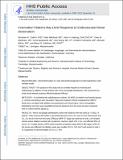| dc.contributor.author | Tzafriri, Abraham R. | |
| dc.contributor.author | Mahfoud, Felix | |
| dc.contributor.author | Keating, John H. | |
| dc.contributor.author | Markham, Peter M. | |
| dc.contributor.author | Spognardi, Anna | |
| dc.contributor.author | Wong, Gee | |
| dc.contributor.author | Fuimaono, Kristine | |
| dc.contributor.author | Böhm, Michael | |
| dc.contributor.author | Edelman, Elazer R. | |
| dc.date.accessioned | 2016-06-06T17:32:14Z | |
| dc.date.available | 2016-06-06T17:32:14Z | |
| dc.date.issued | 2014-09 | |
| dc.date.submitted | 2014-07 | |
| dc.identifier.issn | 07351097 | |
| dc.identifier.uri | http://hdl.handle.net/1721.1/102996 | |
| dc.description.abstract | Background
Renal denervation is a new interventional approach to treat hypertension with variable results.
Objectives
The purpose of this study was to correlate response to endovascular radiofrequency ablation of renal arteries with nerve and ganglia distributions. We examined how renal neural network anatomy affected treatment efficacy.
Methods
A multielectrode radiofrequency catheter (15 W/60 s) treated 8 renal arteries (group 1). Arteries and kidneys were harvested 7 days post-treatment. Renal norepinephrine (NEPI) levels were correlated with ablation zone geometries and neural injury. Nerve and ganglion distributions and sizes were quantified at discrete distances from the aorta and were compared with 16 control arteries (group 2).
Results
Nerve and ganglia distributions varied with distance from the aorta (p < 0.001). A total of 75% of nerves fell within a circumferential area of 9.3, 6.3, and 3.4 mm of the lumen and 0.3, 3.0, and 6.0 mm from the aorta. Efficacy (NEPI 37 ng/g) was observed in only 1 of 8 treated arteries where ablation involved all 4 quadrants, reached a depth of 9.1 mm, and affected 50% of nerves. In 7 treated arteries, NEPI levels remained at baseline values (620 to 991 ng/g), ≤20% of the nerves were affected, and the ablation areas were smaller (16.2 ± 10.9 mm2) and present in only 1 to 2 quadrants at maximal depths of 3.8 ± 2.7 mm.
Conclusions
Renal denervation procedures that do not account for asymmetries in renal periarterial nerve and ganglia distribution may miss targets and fall below the critical threshold for effect. This phenomenon is most acute in the ostium but holds throughout the renal artery, which requires further definition. | en_US |
| dc.description.sponsorship | National Institutes of Health (U.S.) (NIH grant R01 GM-49039) | en_US |
| dc.description.sponsorship | Deutsche Forschungsgemeinschaft (KFO 196) | en_US |
| dc.language.iso | en_US | |
| dc.publisher | Elsevier | en_US |
| dc.relation.isversionof | http://dx.doi.org/10.1016/j.jacc.2014.07.937 | en_US |
| dc.rights | Creative Commons Attribution-NonCommercial-NoDerivs License | en_US |
| dc.rights.uri | http://creativecommons.org/licenses/by-nc-nd/4.0/ | en_US |
| dc.source | PMC | en_US |
| dc.title | Innervation Patterns May Limit Response to Endovascular Renal Denervation | en_US |
| dc.type | Article | en_US |
| dc.identifier.citation | Tzafriri, Abraham R., Felix Mahfoud, John H. Keating, Peter M. Markham, Anna Spognardi, Gee Wong, Kristine Fuimaono, Michael Böhm, and Elazer R. Edelman. "Innervation Patterns May Limit Response to Endovascular Renal Denervation." Journal of the American College of Cardiology, 64:11 (September 2014), pp. 1079-1087. | en_US |
| dc.contributor.department | Massachusetts Institute of Technology. Institute for Medical Engineering & Science | en_US |
| dc.contributor.mitauthor | Edelman, Elazer R. | en_US |
| dc.relation.journal | Journal of the American College of Cardiology | en_US |
| dc.eprint.version | Author's final manuscript | en_US |
| dc.type.uri | http://purl.org/eprint/type/JournalArticle | en_US |
| eprint.status | http://purl.org/eprint/status/PeerReviewed | en_US |
| dspace.orderedauthors | Tzafriri, Abraham R.; Mahfoud, Felix; Keating, John H.; Markham, Peter M.; Spognardi, Anna; Wong, Gee; Fuimaono, Kristine; Böhm, Michael; Edelman, Elazer R. | en_US |
| dspace.embargo.terms | N | en_US |
| dc.identifier.orcid | https://orcid.org/0000-0002-7832-7156 | |
| mit.license | PUBLISHER_CC | en_US |
